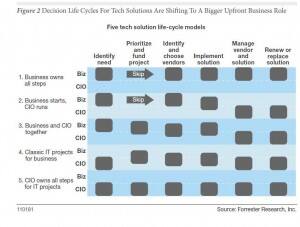A report authored by Andrew Bartels - VP and principal analyst at Forrester Research addresses the hotly debated question among CIOs and vendors alike - how much control of tech spending has shifted away from the CIO and moved into the hands of line of-business managers. The report provides a framework for answering that question.
Applying that framework against the detailed breakdown of the new technology purchases in the US from 2009 to 2015, Forrester estimates that just 7.2 percent of total US spending on new technologies in 2015 will be executed by business units without CIO involvement - a share that, based on trends, is not likely to rise dramatically. Another 10 percent will be new technology spending that starts with the business but then involves the CIO’s department for implementation and management. The largest share - more than a third - will be projects where the CIO’s team and business jointly handle all the stages of the tech-buying process. The remainder - a share shrinking from almost 55 percent in 2009 to less than 47 percent by 2015 - consists of a combination of “classic IT” new projects that the CIO’s department initiates with business involvement and then implements and manages, or technology-specific purchases where the CIO’s department manages all phases.
Key takeaways from the report include:
The Proportion Of Tech Spending Controlled By Business Is Small, Though Rising
Technology that business units identify, choose, implement, and run without CIO involvement was just 6.3 percent of US new tech purchases in 2013 and rising by about a half percentage point per year. Another 9 percent (and rising) is technology where the business identifies and chooses the vendor, but the CIO’s organisation is involved in implementation and management.
More Than A Third Of Tech Spending Will Be Joint Business/Tech Management Purchases
The ideal tech-buying process is one in which the business and the CIO’s team work together to identify a need, find and fund a solution, choose the right vendor or vendors, implement it, and manage it. Forrester estimates that more than a third of tech purchases will fit that profile by 2015.
Traditional Tech Purchases Led By The CIO’s Department Are Shrinking From 55% To 47%
Tech purchases that the CIO’s department primarily or exclusively makes are still almost half of all new tech purchases, but that share is falling.
“Pundits who make sweeping statements about tech spending shifting from the CIO’s department to the business fail to appreciate the complex process involved in buying and owning technology,” says Bartels in the report.
The report identifies the six key decision stages of the technology life cycle. And using the degree of participation by business and technology roles in these stages, there emerge five general patterns for the roles that business units and tech management will play in the decisions at each stage. Even if and as business units take a leading role in the front-end stages of this technology life cycle, tech management will continue to play a leading role in decisions at the middle and later stages of the tech decision life cycle. That’s because business units’ interest in running technology is far lower than their interest in buying technology, so the CIO’s organisation will sooner or later end up with the task and the cost of running the technology that has been purchased.

Bartels also informs CIOs that the magnitude and nature of the shift should not be a source of alarm. The fact that business users are taking the lead in identifying opportunities to apply technology solutions to business problems is a good thing, not something to be deplored. What a CIOs need to do, though, is to make sure that they have a strong enough relationship with the business partners that they will come to IT for guidance and support in choosing the right vendor, help in negotiating the right price, assistance in implementing the solution with security and appropriate integration to other systems, and management of the solution and the vendor once it is in place.
)